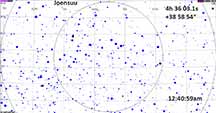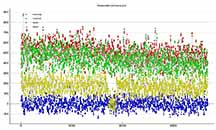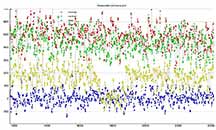

This event goes through Santa Cruz, and the probability of a "hit" from home for Kirk and I is good. The star is decently bright, at good altitude (alt=47, Az=290), and a deep drop for up to 6 seconds, giving the probability of a high accuracy positional measurement from short integration. Skies have a decent chance of being clear, as the last storm system leaves about that time.
 |
 |
Kirk and I both had good success from home. 5s occultations. Karl tried it as well, but low battery power foiled his attempt.
Nolthenius Data Pyote Log File
I observed from the foot of my driveway. Clear skies, no clouds. Post cold front damp cold and convective conditions. I set at 4x; 8x it was almost too bright, 4x it was almost consistently visible, I was undecided till right before recording, and went with 4x. The event was clear even visually on the monitor, however, even though the recording shows the star barely visible. PyMovie found the data well enough to get a solid event. Reported to IOTA 1/19/23
|
PyMovie, both tracking stars, the target in baige, and the sky in green |
The target. I wonder about the drop early in the recording. |
Zoomed in on the event. Lots of scintillation |
Tracking star, brighter and better stability. |
|
No chance of a false positive |
In Pyote, after block integration. The suspicious dip near the beginning did not get recognized by PyOTE. Kirk will look at his own tape to see if there was anything going on then. |
The primary occultation with better accuracy than I'd expected. |
Kirk observed from his driveway, recorded at 8X setting, for 2 minutes, analyzed in frame mode in PyMovie, and PyOTE identified and block integrated properly. There was a very thin cloud which drifted through during the event, visible as a slow trend in brightness for both the target and for tracking star, and this was corrected for in PyOTE using "reference".
 |
 |
 |
PyOTE analysis:
 |
 |
 |
magDrop report: percentDrop: 92.9 magDrop: 2.877 +/- 1.495 (0.95 ci)